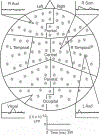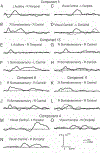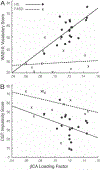Covariation Between Brain Function (MEG) and Structure (DTI) Differentiates Adolescents with Fetal Alcohol Spectrum Disorder from Typically Developing Controls
- PMID: 33010344
- PMCID: PMC8056938
- DOI: 10.1016/j.neuroscience.2020.09.053
Covariation Between Brain Function (MEG) and Structure (DTI) Differentiates Adolescents with Fetal Alcohol Spectrum Disorder from Typically Developing Controls
Abstract
The behavioral, cognitive, and sensory difficulties experienced by individuals exposed to alcohol prenatally currently fail to provide early identification for fetal alcohol spectrum disorder (FASD). Attempting to advance this pursuit through a multivariate analysis, we collected magnetoencephalography (MEG) data during auditory, somatosensory, visual paradigms, DTI, and behavior in adolescents ages 12-21 years (FASD: N = 13; HC: N = 20). We assessed the relationship between brain function (MEG) and structure (fractional anisotropy (FA)) utilizing joint independent component analysis (jICA), and examined how this measure relates to behavior. We identified 5 components that reveal group differences in co-variation between MEG and FA. For example, component 5 (t = 3.162, p = 0.003, Hedges' g = 1.13) contained MEG activity corresponding to all three sensory modalities, most robustly in occipital lobes, and DTI-derived cerebellar FA, underlying the role of the cerebellum in sensory processing. Further, in HCs component 5's loading factor was positively correlated with verbal ability (r = 0.646, p = 0.002), indicating higher covariation was associated with better verbal performance. Interestingly, this relationship is lacking in FASD (r = 0.009, p = 0.979). Also, component 5 loading factor negatively correlated with impulsivity (r = -0.527, p = 0.002), indicating that stronger function-structure associations were associated with individuals with lower impulsivity. These findings suggest that multimodal integration of MEG and FA provides novel associations between structure and function that may help differentiate adolescents with FASD from HC.
Keywords: diffusion tensor imaging (DTI); fractional anisotropy (FA); joint independent component analysis (jICA); magnetoencephalography (MEG); prenatal alcohol exposure (PAE).
Copyright © 2020 IBRO. Published by Elsevier Ltd. All rights reserved.
Figures





Similar articles
-
Using joint ICA to link function and structure using MEG and DTI in schizophrenia.Neuroimage. 2013 Dec;83:418-30. doi: 10.1016/j.neuroimage.2013.06.038. Epub 2013 Jun 15. Neuroimage. 2013. PMID: 23777757 Free PMC article. Clinical Trial.
-
Sex differences in associations between white matter microstructure and gonadal hormones in children and adolescents with prenatal alcohol exposure.Psychoneuroendocrinology. 2017 Sep;83:111-121. doi: 10.1016/j.psyneuen.2017.05.019. Epub 2017 May 26. Psychoneuroendocrinology. 2017. PMID: 28609669 Free PMC article.
-
Altered Neural Oscillations During Multisensory Integration in Adolescents with Fetal Alcohol Spectrum Disorder.Alcohol Clin Exp Res. 2017 Dec;41(12):2173-2184. doi: 10.1111/acer.13510. Epub 2017 Oct 30. Alcohol Clin Exp Res. 2017. PMID: 28944474 Free PMC article.
-
The role of diffusion tensor imaging and fractional anisotropy in the evaluation of patients with idiopathic normal pressure hydrocephalus: a literature review.Neurosurg Focus. 2016 Sep;41(3):E12. doi: 10.3171/2016.6.FOCUS16192. Neurosurg Focus. 2016. PMID: 27581308 Review.
-
Neuroimaging effects of prenatal alcohol exposure on the developing human brain: a magnetic resonance imaging review.Acta Neuropsychiatr. 2015 Oct;27(5):251-69. doi: 10.1017/neu.2015.12. Epub 2015 Mar 17. Acta Neuropsychiatr. 2015. PMID: 25780875 Review.
Cited by
-
School-aged children diagnosed with an FASD exhibit visuo-cortical network disturbance: A magnetoencephalography (MEG) study.Alcohol. 2022 Mar;99:59-69. doi: 10.1016/j.alcohol.2021.12.001. Epub 2021 Dec 13. Alcohol. 2022. PMID: 34915151 Free PMC article.
-
Prenatal alcohol exposure and associations with physical size, dysmorphology and neurodevelopment: a systematic review and meta-analysis.BMC Med. 2024 Oct 15;22(1):467. doi: 10.1186/s12916-024-03656-w. BMC Med. 2024. PMID: 39407296 Free PMC article.
-
Dynamics of microglia and dendritic spines in early adolescent cortex after developmental alcohol exposure.Dev Neurobiol. 2021 Sep;81(6):786-804. doi: 10.1002/dneu.22843. Epub 2021 Aug 1. Dev Neurobiol. 2021. PMID: 34228891 Free PMC article.
-
Recent breakthroughs in understanding the cerebellum's role in fetal alcohol spectrum disorder: A systematic review.Alcohol. 2024 Sep;119:37-71. doi: 10.1016/j.alcohol.2023.12.003. Epub 2023 Dec 13. Alcohol. 2024. PMID: 38097146
-
Impact of Developmental Alcohol Exposure on the Thalamus.Adv Exp Med Biol. 2025;1473:67-92. doi: 10.1007/978-3-031-81908-7_4. Adv Exp Med Biol. 2025. PMID: 40128475 Review.
References
-
- Adams CM, Kodituwakku PW, Hay A, May PA (2001). Patterns of cognitive-motor development in children with fetal alcohol syndrome from a community in South Africa. Alcohol Clin Exp Res, 25:557–562. - PubMed
-
- Alexander GE, DeLong MR, Strick PL (1986). Parallel organization of functionally segregated circuits linking basal ganglia and cortex. Annu. Rev. Neurosci. 9:357–381. - PubMed
-
- Almairac F, Herbet G, Moritz-Gasser S, de Champfleur NM, Daffau H (2015). The left inferior fronto-occipital fasciculus subserves language semantics: a multilevel lesion study. Brain Struct Funct. 220:1983–95. - PubMed
Publication types
MeSH terms
Grants and funding
LinkOut - more resources
Full Text Sources
Medical

